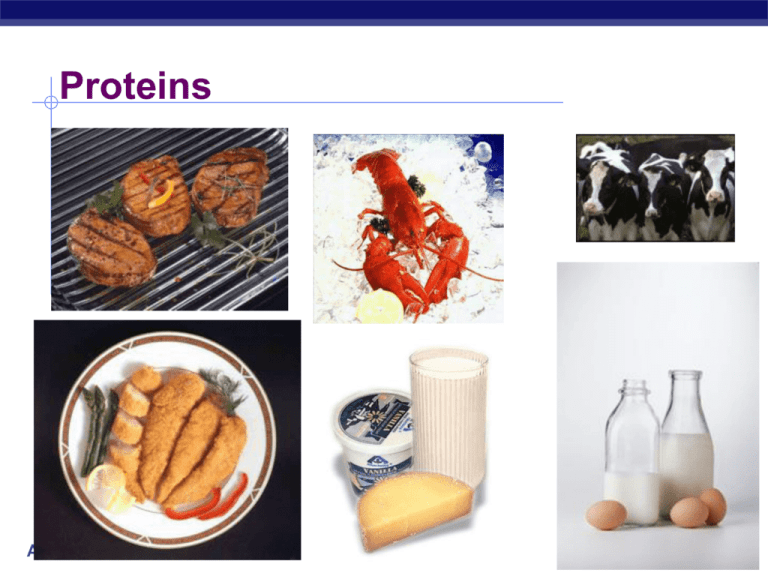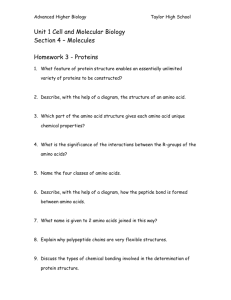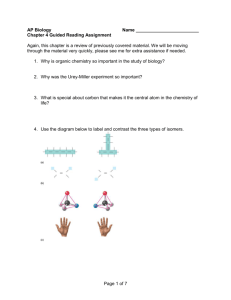AP Biology proteins ppt
advertisement

Proteins AP Biology Proteins Multipurpose molecules AP Biology 2008-2009 Proteins Most structurally & functionally diverse group Function: involved in almost everything AP Biology enzymes (pepsin, DNA polymerase) structure (keratin, collagen) carriers & transport (hemoglobin, aquaporin) cell communication signals (insulin & other hormones) receptors defense (antibodies) movement (actin & myosin) storage (bean seed proteins) Proteins Structure H2O monomer = amino acids 20 different amino acids polymer = polypeptide protein can be one or more polypeptide chains folded & bonded together large & complex molecules complex 3-D shape hemoglobin AP Biology Rubisco growth hormones Amino acids Structure central carbon amino group carboxyl group (acid) R group (side chain) H O H | || —C— C—OH —N— | H R variable group different for each amino acid confers unique chemical properties to each amino acid like 20 different letters of an AP Biology alphabet can make many words (proteins) Oh, I get it! amino = NH2 acid = COOH Effect of different R groups: Nonpolar amino acids nonpolar & hydrophobic Why are these nonpolar & hydrophobic? AP Biology Effect of different R groups: Polar amino acids polar or charged & hydrophilic AP Biology Why are these polar & hydrophillic? Ionizing in cellular waters AP Biology H+ donors Ionizing in cellular waters AP Biology H+ acceptors Sulfur containing amino acids Form disulfide bridges covalent cross links betweens sulfhydryls stabilizes 3-D structure H-S – S-H You wondered why perms smell like rotten eggs? AP Biology Building proteins Peptide bonds covalent bond between NH2 (amine) of one amino acid & COOH (carboxyl) of another C–N bond H2O dehydration synthesis AP Biology peptide bond Building proteins Polypeptide chains have direction N-terminus = NH2 end C-terminus = COOH end repeated sequence (N-C-C) is the polypeptide backbone can only grow in one direction AP Biology Protein structure & function Function depends on structure 3-D structure twisted, folded, coiled into unique shape pepsin hemoglobin AP Biology collagen Primary (1°) structure Order of amino acids in chain amino acid sequence determined by gene (DNA) slight change in amino acid sequence can affect protein’s structure & its function even just one amino acid change can make all the difference! AP Biology lysozyme: enzyme in tears & mucus that kills bacteria Sickle cell anemia I’m hydrophilic! AP Biology Just 1 out of 146 amino acids! But I’m hydrophobic! Secondary (2°) structure “Local folding” folding along short sections of polypeptide interactions between adjacent amino acids H bonds weak bonds between R groups forms sections of 3-D structure -helix -pleated sheet AP Biology Secondary (2°) structure AP Biology Tertiary (3°) structure “Whole molecule folding” interactions between distant amino acids hydrophobic interactions cytoplasm is water-based nonpolar amino acids cluster away from water H bonds & ionic bonds disulfide bridges covalent bonds between AP Biology sulfurs in sulfhydryls (S–H) anchors 3-D shape Quaternary (4°) structure More than one polypeptide chain bonded together only then does polypeptide become functional protein hydrophobic interactions AP Biology = skin & tendons collagen hemoglobin Protein structure (review) R groups hydrophobic interactions disulfide bridges (H & ionic bonds) 3° multiple polypeptides hydrophobic interactions 1° amino acid sequence peptide bonds determined by DNA AP Biology 4° 2° R groups H bonds Protein denaturation Unfolding a protein In Biology, size doesn’t matter, SHAPE matters! conditions that disrupt H bonds, ionic bonds, disulfide bridges temperature pH salinity alter 2° & 3° structure alter 3-D shape destroys functionality some proteins can return to their functional shape after denaturation, many cannot AP Biology EAT Let’s build X some Proteins! AP Biology 2008-2009 Ghosts of Lectures Past (storage) AP Biology 2007-2008 Chaperonin proteins Guide protein folding AP Biology provide shelter for folding polypeptides keep the new protein segregated from cytoplasmic influences Protein models Protein structure visualized by X-ray crystallography extrapolating from amino acid sequence computer modelling lysozyme AP Biology







